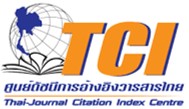The Structural and Morphology of Hydrothermally Grown ZnO Nanorods on Zinc Sheets Towards 3D-Hybrid SERS Applications
Keywords:
Zinc oxide, Surface Enhanced Raman Spectroscopy, Reusability; Hydrothermal process, Handheld Raman spectroscopyAbstract
This research studies the fabrication of surface-enhanced Raman spectroscopy (SERS) substrate with self-cleaning effect and can be reusability. Start with the preparation of zinc oxide on the zinc sheet with the hydrothermal process by observing the effects of time to grow crystals of zinc oxide nanorods with hexagonal structures. In the experiment, we studied the characteristics of ZnO nanorod structures depending on precursors of zinc nitrate (Zn(NO3)2) : hexamethylentetramine (HMTA) at 1:1 ratio, in DI water at concentration of 10 mM by varying growth time at 4 ‒ 10 h. The prepared zinc oxide templates were finally decorated with gold (Au) nanoparticles with the sputtering deposition technique for 90 seconds. From physical observations was investigated by the field emission scanning electron microscopic (FE-SEM) showed the length of ZnO nanorods was increased from 774 ‒ 1660 nm corresponding with the growth time increased. After Au decoration ZnO nanorods were characterized by transmission electron microscopy (TEM). The prepared SERS substrates were finally measured for the Raman enhancement by Handheld Raman spectroscopy with Rhodamine 6G (R6G) as the test molecules and test reusability efficiency. The growth time of hydrothermal at 6 h shows that the high performance of enhanced Raman signal and minimum cleaning time is 10 minutes. The results show that the SERS substrates can be detected the R6G solution at the limit of detection of
1 × 10‒6 M. In addition, the SERS substrates were tested reusability up to 10 cycles with the UV cleaning process.








